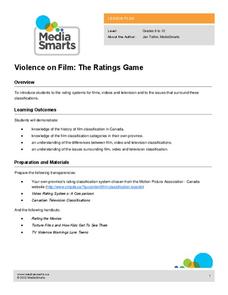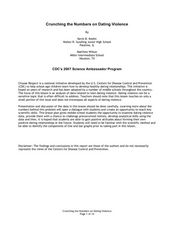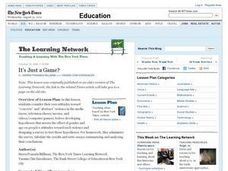Media Smarts
The Impact of Gender Role Stereotypes
One of three lessons on gender stereotype, this resource from the Media Awareness Network discusses the violence that is inflicted on men and women as they try to live up to the stereotypes of their gender. The section on women focuses...
Media Smarts
Violence and Video Games
Widespread video gaming makes this content relevant and high interest. Developing youth awareness about the impact of violence in games is important to promote literacy, critical thinking, health, and consumer awareness. After reading...
Media Smarts
Taking Charge of TV Violence
Encourage your class to become aware of the violence that is present in children's television programs and how this violence can influence children. Do this by holding the planned class discussion in this lesson plan and providing...
Media Smarts
Violence on Film: The Ratings Game
Learn about film and TV ratings systems in Canada (includes a comparison to the MPAA system) and how they influence appropriate viewing for youths. A detailed commentary about the film Seven pointed at revealing flaws in ratings systems...
Media Smarts
Violence on Television
Focus on a specific incident of violence on television in the case of the Canadian Broadcast System showing Silence of the Lambs on public television. Look at the broadcasting codes and a complaint that was filed against the Association....
Media Smarts
Facing TV Violence: Consequences and Media Violence
Make your class aware of the difference between media violence and real violence. Using prior knowledge, a video clip, and a worksheet, class members explore and discuss the unrealistic portrayal of violence in the media. Learners...
National Woman's History Museum
Sally Hemings: Raising a Family Amidst the Brutality of Slavery
Pupils may know about early American figures such as Phyllis Wheatley and Abigail Adams, but what about Sally Hemings? Sally Hemings was the mother of Thomas Jefferson's children, but she is often left in the shadows of history....
Curated OER
Life Rules for Nonviolence
Scholars apply the basic ideas of Mohandis Gandhi and their application in global change. They generate original definitions of violence and nonviolence. They then create their own set of basic rules that they can apply in real...
Deliberating in a Democracy
Violent Video Games
High schoolers examine violence in video games. In this American history instructional activity, students read an article on the link between video games and violence. High schoolers respond to discussion questions and debate the topic.
Curated OER
Hockey and Violence
Students research various aspects of hockey violence. They check the Internet (with sites below and others) and see what has been done to prevent violence at the professional level and/or the amateur level.
Curated OER
Another Look at School Safety
Pupils research crime and violence in their district, including finding out what has been discussed about safety and addition of surveillance cameras.Students conduct interviews and explore the legal issues involved. After all...
Curated OER
Debate Topics and Ideas
Students examine both sides of arguments surrounding given debates. They use the internet and other research to collect information to support their stand on the controversial issue. Students debate their chosen topic. This lesson plans...
Curated OER
Crunching the Numbers on Dating Violence
Students read about potential violent relationships and beliefs about dating. In this relationship lesson students use graphs to examine data about healthy realtionshipsand draw conclusions on their results.
Curated OER
Non-Violence Means "Doing Nothing"
Students reflect on violence and non-violence. In this World History lesson, students read an article by Gandhi then write an essay as to whether they agree or disagree with his thoughts. Students then share all their ideas...
Curated OER
A New Generation of Fighters
Young scholars discuss the reasons why people are less likely to take a stand on issues today than they were in the past. In groups, they research the efforts of Kings, Parks and others to end discrimination and racism. They read...
Curated OER
Those Tear-Me-Apart, Put-Me-Back-Together, Never-Be-the-Same-Again Blues
Students discuss what it might be like to be the new person in a group, choose the correct words for an apology, learn a vivid instructional activity about how unking words can hurt others, and write a paragraph to explain what they...
Curated OER
The Inside Dope on Video Games
Students explore the claim that video games that glorify violence and illegal activities also promote such activities in the real world. They choose sides and perform a mock trial on the issue.
Curated OER
is Love Supposed To Hurt? Discussing Violence in Relationships And Ways To Stop It
Students discuss violence and abuse in dating and family relationships, and how to recognize an abusive relationship, explore attitudes about healthy behavior in close relationships, and discuss ways to avoid and get out of unhealthy...
Curated OER
Kaffir Boy
Students explore the concepts of intolerance and racism in the autobiography Kaffir Boy written by Mark Mathabane. The instructional activity reveals the story's depiction of the terrible toll of apartheid on the lives of individuals.
Curated OER
Understanding Persuasive Writing
High schoolers give examples of how the media glamorize violence and desensitize viewers to the horrors of real acts of violence. They identify factors in addition to the media that contribute to the problem of violence in society.
Curated OER
A Twisted Love Poem
High schoolers read poem about dating violence, discuss meaning of the poem, and compose essay about their interpretation and reactions to it.
Curated OER
Crime Watch
Learners analyze the recent rise of homicides in some American cities, create and share posters, and write reflective essays in the form of letters to community leaders.
Curated OER
Bullying Reality Quiz
Students take a quiz about school violence and create their own quiz on bullying.
Curated OER
It's Just a Game?
Students consider their attitudes toward concrete and abstract violence in the media before developing hypotheses that assess the effect of gender and age on people's attitudes toward such violence and designing a survey to test those...

























